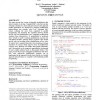Free Online Productivity Tools
i2Speak
i2Symbol
i2OCR
iTex2Img
iWeb2Print
iWeb2Shot
i2Type
iPdf2Split
iPdf2Merge
i2Bopomofo
i2Arabic
i2Style
i2Image
i2PDF
iLatex2Rtf
Sci2ools
HPDC
2009
IEEE
2009
IEEE
Pluggable parallelisation
This paper presents the concept of pluggable parallelisation that allows scientists to develop “sequential like” codes that can take advantage of multi-core, cluster and grid systems. In this approach parallel applications are developed by plugging parallelisation patterns/idioms into scientific codes (e.g., “sequential like” codes), softening the move from sequential to parallel programming and promoting the separation between domain specific code and parallelisation issues. Pluggable parallelisation combines three characteristics: 1) parallelisation is performed from “outside to inside”, localising parallelisation concerns into well defined modules, reducing changes required to the domain specific code and avoiding invasive parallelisation of base code; 2) control view is separated from data view promoting a stronger separation of concerns which improves reuse of parallelisation concerns across platforms and enables fine-grained refinements; bstractions can be composed, ...
Distributed Computing | Domain Specific Code | HPDC 2009 | Parallel Programming | Pluggable Parallelisation |
| Added | 21 May 2010 |
| Updated | 21 May 2010 |
| Type | Conference |
| Year | 2009 |
| Where | HPDC |
| Authors | Rui C. Gonçalves, João Luís Sobral |
Comments (0)

